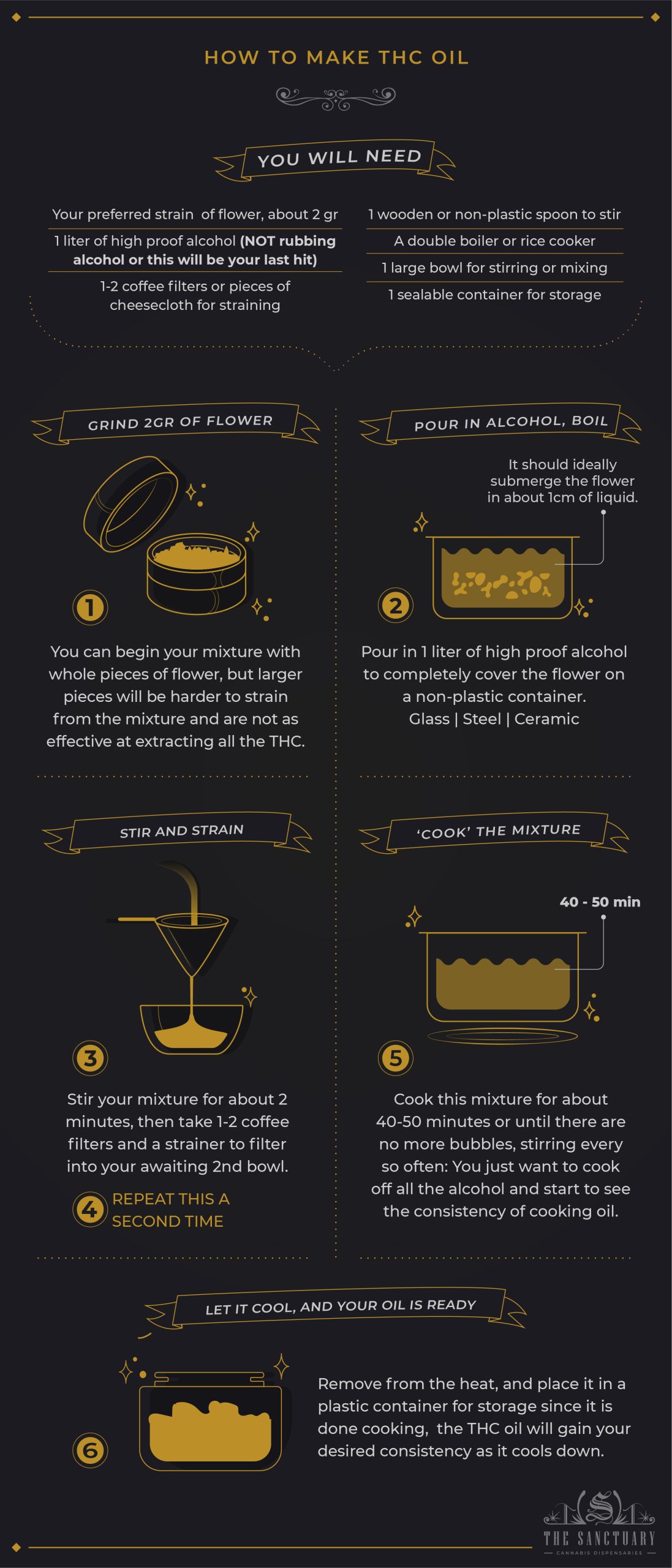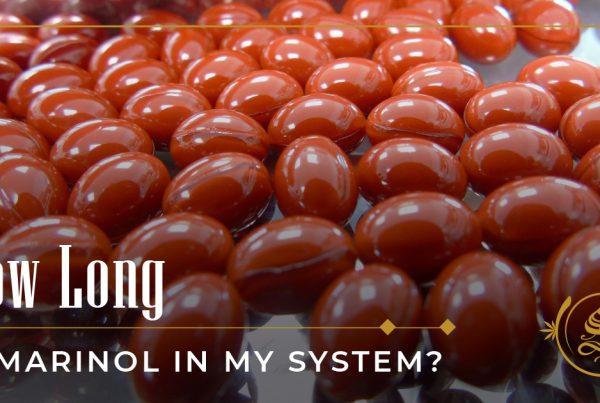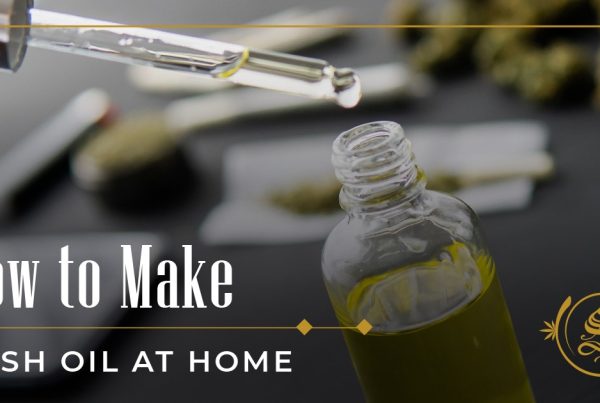One of the most effective ways of concentrating THC is through infused or extracted oils, which have a versatile range of uses for medicine and recreation.
The easiest way to re-up on your THC oil may very well be a quick trip to the dispensary or have it delivered, but what if those aren’t always an option (low on funds, bad weather, etc.)?
As seen by finding ways to smoke weed out of the most common household items, no rain, sleet or snow can stop you enjoying your products, and THC oil is no exception.
How to Make THC Oil
The entire process is simply mixing your crushed flower with a high proof alcohol, straining and adding just enough heat to cook off the excess alcohol.
For your tool belt of utensils, you will only need:
- Your preferred strain of flower, about 2 grams
- 1 liter of high proof alcohol (NOT rubbing alcohol or this will be your last hit)
- 1-2 coffee filters or pieces of cheesecloth for straining
- 1 wooden or non-plastic spoon to stir
- A double boiler or rice cooker
- 1 large bowl for stirring or mixing
- 1 sealable container for storage
Less than an hour of cooking time, and a recipe easy enough to make after work, will give you cannabis oil that will last you for months on end (depending on how much you make and how often you use it).
THC oil allows you to enjoy the benefits of your cannabis flower without having to inhale smoke or buy devices for consumption, and it does not cost anything to make at home besides your preferred strain and the oil/alcohol you choose to mix.
Flower, alcohol and a half dozen basic kitchen tools, that you probably have at the ready right now, will be all you need to make your THC oil at home, and the process is just as easy:
STEP 1: Grind 2 grams of flower
You can actually skip this step (talk about easy, right?) and begin your mixture with whole pieces of flower, but larger pieces will be harder to strain from the mixture and are not as effective at extracting all the THC.
Crushing your flower guarantees even distribution throughout the oil and smaller pieces reduce cooking time.
STEP 2: Pour in Alcohol, Boil
Once your flower is prepared in a non-plastic container, pour in 1 liter of high proof alcohol to completely cover the flower. Plastic has chemicals that react differently to the mixture, so go for a glass, steel or ceramic bowl for this step.
1 liter should ideally submerge the flower in about 1 centimeter (cm) of liquid, but adjust as needed.
STEP 3: Stir and Strain
Stir your mixture for about 2 minutes, then take 1-2 coffee filters and a strainer to filter into your awaiting 2nd bowl.
STEP 4: Repeat Step 3
Repeating this process one to two more times will concentrate all the THC from the flower and into the mixture, giving your liquid a noticeably greener color.
STEP 5: ‘Cook’ the Mixture
Bringing out your inner Walter White, you’ll cook this mixture for about 40-50 minutes or until there are no more bubbles, stirring every so often: You just want to cook off all the alcohol and start to see the consistency of cooking oil.
STEP 6: Let it Cool, and Your Oil is Ready
Remove from the heat, and your homemade THC oil will gain your desired consistency as it cools down.
Also, the oil can now be placed in a plastic container for storage since it is done cooking. While the mixture is in the process of cooking and being stirred, you will want to use a different material.
That’s really all there is to it to making basic THC oil that is not for vape concentrates. But luckily, that is another easy recipe that you can follow here.
Storing Your Homemade Oil
Do Not refrigerate immediately off the heat as this can affect the temperature inside your fridge and the food inside: Wait until you are able to pick up and handle the container with your fresh oil, and it is ready to chill at that time.
THC oil will last for about 2 months at room temperature, away from direct sunlight, but it will last longer in the fridge by several months.
Using This Recipe to Infuse Oils at Home
You just made your own THC oil, way to go! A multitude of uses from such a simple recipe is great on its own, and it doesn’t even stop there: You can use this exact technique (only with a few small changes) to infuse any oil you have and make a quality, at-home replacement until your next trip to the dispensary.
Cooking Oil
All you need to start is another gram of crushed flower and the cooking oil of your choice: canola, peanut, vegetable, whichever you have a taste for and want to use for homemade edibles can be infused simply by:
- Mixing crushed flower with 1 cup of desired oil in lew of alcohol
- Low simmer for up 2 hours, stirring every 10 minutes
- Strain with coffee filters or cheese cloth
Coconut Oil
Again, you can do this with any oil you choose, but coconut oil is also a great vegan substitute for cannabutter and it is just as easy to infuse as any other oil:
- 1 cup of coconut oil mixed with crushed flower
- Low simmer for up to 2 hours and stirring
- Strain with coffee filters or cheese cloth
Noticing a pattern here? Infusing or making your own THC oil is as easy as just finding the right liquid to infuse with your preferred strain, then following the three basic steps.
Cannabutter
For more traditional or non-vegan recipes, cannabutter is the golden standard for any at-home bakers looking to make edibles. Luckily, infusing your butter is not much harder than infusing oils and will last in the fridge or freezer for up to six months.
To make cannabutter, you will need:
- 4 grams to one ounce of flower since you are now infusing butter instead of a thin liquid, so adjust as necessary.
- 2 sticks of quality, unsalted butter with up to an ounce of decarbed flower will fit perfectly into a mason jar, which goes into a pot lined with a kitchen towel.
- Fill the towel-lined pot with 4-5 cups of water.
- The mason jar stands upright in the water for 2 hours on a low simmer.
- Stir and strain the mixture before refrigerating until the butter solids.
You can keep your homemade cannabutter refrigerated for up to 2 weeks or in the freezer for up to 6 months.







